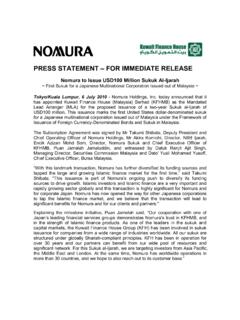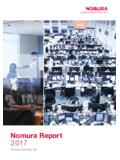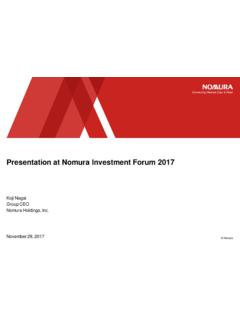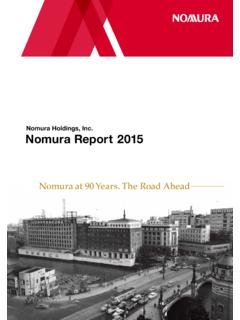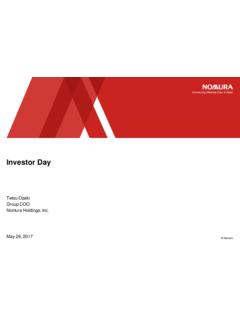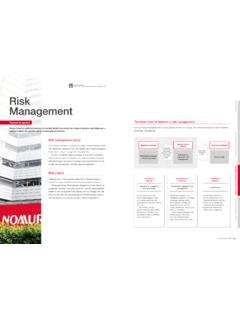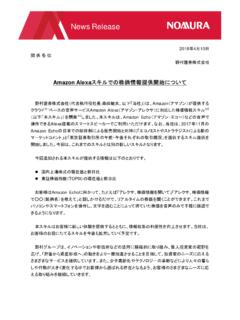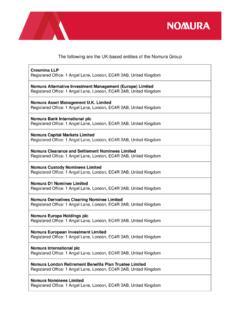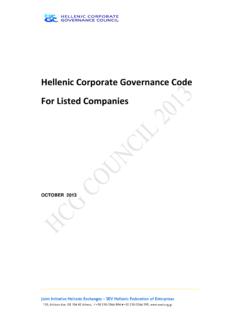Transcription of Consolidated Financial Statements under US GAAP …
1 Consolidated Financial Statements under US GAAP. Nomura Holdings, Inc. December 2001. 1. This is a summary of the presentation on Consolidated Financial Statements under US GAAP. Date: December 14, 2001 (Friday). Place: Nihonbashi Headquaters of Nomura Securities Co., Ltd. Speaker: Akira Maruyama, General Manager of Finance Dept. Outline of the Presentation n NYSE Listing and US GAAP Financials n Segment Information NYSE Listing 4 Year ended March 31, 2000 17. Year ended March 31, 2000 5 Year ended March 31, 2001 18. Year ended March 31, 2001 6. Major Differences between US GAAP and Japanese GAAP (P/L) 7. Major Differences between US GAAP and n Appendix 19. Japanese GAAP (B/S) 9. n Investments in Equity Securities and Principal Finance Group Investments in Equity Securities 12. PFG Business Overview 13. PFG Major Investments 14. Potential Restructuring of PFG Business 15. 1.
2 Nothing in this document shall be considered as an offer to sell or solicitation of an offer to buy any security, commodity or other instrument, including securities issued by Nomura or any affiliate thereof. Offers to sell, sales, solicitations to buy, or purchases of anysecurities issued by Nomura or any affiliate thereof may only b e made or entered into pursuant to appropriate offering materials or a prospectus prepared and distributed according to the laws, regulations, rul es and market practices of the jurisdictions in which such offers or sales may be made. 2. No part of this document shall be reproduced, stored in a retrie val system or transmitted in any form or by any means, electronic, mechanical, photocopying, recording or otherwise, without theprior written permission of Nomura. 3. The information and opinions contained in this document have bee n obtained from sources believed to be reliable, but no represen tations or warranty, express or implied, are made that such info rmation is accurate or complete and no responsibility or liability can be a ccepted by Nomura for errors or omissions or for any losses arising from the use of this information.
3 4. This document contains Statements that may constitute, and from time to time our management may make "forward -looking Statements " within the meaning of the safe harbor provisions of The Private Securities Litigation Reform Act of 1995. Any such Statements must be read in the context of the offering materials pursuant to which any securities may be offered or sold in the United States. These forward - looking Statements are not historical facts but instead represent only our belief regarding future events, many of which, by their nature, are inherently uncertain and outside our control. Imp ortant factors that could cause actual results to differ from those in specific forward -looking Statements include, without limitation, economic and market conditions, political events and investor sentiments, liquidity of secondary markets, level and volatility of interest rates, currency exchange rates, security valuations, competitive conditions and size, and the number and timing of transactions.
4 2. 1. Nothing in this document shall be considered as an offer to sell or solicitation of an offer to buy any security, commodity or other instrument, including securities issued by Nomura or any affiliate thereof. Offers to sell, sales, solicitations to buy, or purchases of any securities issued by Nomura or any affiliate thereof may only be made or entered into pursuant to appropriate offering materials or a prospectus prepared and distributed according to the laws, regulations, rules and market practices of the jurisdictions in which such offers or sales may be made. 2. No part of this document shall be reproduced, stored in a retrieval system or transmitted in any form or by any means, electronic, mechanical, photocopying, recording or otherwise, without the prior written permission of Nomura. 3. The information and opinions contained in this document have been obtained from sources believed to be reliable, but no representations or warranty, express or implied, are made that such information is accurate or complete and no responsibility or liability can be accepted by Nomura for errors or omissions or for any losses arising from the use of this information.
5 4. This document contains Statements that may constitute, and from time to time our management may make, "forward-looking Statements " within the meaning of the safe harbor provisions of The Private Securities Litigation Reform Act of 1995. Any such Statements must be read in the context of the offering materials pursuant to which any securities may be offered or sold in the United States. These forward-looking Statements are not historical facts but instead represent only our belief regarding future events, many of which, by their nature, are inherently uncertain and outside our control. Important factors that could cause actual results to differ from those in specific forward-looking Statements include, without limitation, economic and market conditions, political events and investor sentiments, liquidity of secondary markets, level and volatility of interest rates, currency exchange rates, security valuations, competitive conditions and size, and the number and timing of transactions.
6 NYSE Listing and US GAAP Financials 3. NYSE Listing n Purposes To clearly demonstrate in Japan and overseas that our goal is to become a globally competitive Japanese Financial services group To enhance information disclosure conforming to the spirit of fair disclosure To expand our strategic options To strengthen corporate governance n Schedule December 13, 2001 Official Filing of Registration Statement with SEC. December 17, 2001 Listing on NYSE. n ADR. Form American Depositary Share (ADS) represented NMR. by American Depositary Receipt (ADR. Code NMR. Conversion Rate 1:1 (1 ADS 1 Share). 4. NYSE Listing and US GAAP Financial (1). NYSE listing. The main purposes of the listing are: 1. To clearly demonstrate in Japan and overseas that our goal is to become a globally competitive Japanese Financial services group 2. To enhance information disclosure conforming to the spirit of fair disclosure 3.)
7 To expand our strategic options 4. To strengthen corporate governance As for the schedule, 1. On December 13, 2001, we officially filed our statement of registration with SEC. 2. On December 17, 2001, our shares will be listed on the New York Stock Exchange in the form of American Depositary Shares represented by American Depositary Receipts (ADR). Year ended March 31, 2000. n Operating Results US GAAP Japanese GAAP. Net Revenue* 1, billion yen billion yen Income before Income Taxes billion yen billion yen Net Income billion yen billion yen n Balance Sheet Total Assets 14, billion yen 18, billion yen Total Liabilities 13, billion yen 17, billion yen Shareholders' Equity 1, billion yen 1, billion yen Leverage** times times n ROE** * Net Revenue: Total revenue Interest expense ** Leverage: Total assets divided by shareholders' equity 5. ** ROE: Net income divided by average shareholders' equity NYSE Listing and US GAAP Financial (2).
8 US GAAP and Japanese GAAP for the year ended March 31, 2000. under US GAAP: 1. Net revenue is 1, billion yen 2. Income before income taxes is billion yen, and 3. Net income is billion yen On the other hand, net income under Japanese GAAP was billion yen, much lower than net income under US GAAP. As for balance sheet data as of March 31, 2000: 1. Total assets stood at 14, billion yen 2. Total liabilities were 13, billion yen 3. Shareholders' equity was 1, billion yen As a result, the Financial leverage is times and ROE is As for the balance sheet items, the figures under US GAAP are smaller. Year ended March 31, 2001. n Operating Results US GAAP Japanese GAAP. Net Revenue* billion yen billion yen Income before Income Taxes billion yen billion yen Net Income billion yen billion yen n Balance Sheet Total Assets 17, billion yen 20, billion yen Total Liabilities 15, billion yen 18, billion yen Shareholders' Equity 1, billion yen 1, billion yen Leverage** times times n ROE** * Net Revenue: Total revenue Interest expense ** Leverage: Total assets divided by shareholders' equity ** ROE: Net income divided by average shareholders' equity 6.
9 NYSE Listing and US GAAP Financial (3). US GAAP and Japanese GAAP for the year ended March 31, 2001. under US GAAP, 1. Net revenue was billion yen 2. Income before income taxes was billion yen, and 3. Net income was billion yen, which is lower than under Japanese GAAP. As for balance sheet data as of March 31, 2001: 1. Total assets were 17, billion yen 2. Total liabilities stood at 15, billion yen 3. Shareholders' equity was 1, billion yen As a result, the Financial leverage is times and ROE is Major Differences between US GAAP and Japanese GAAP (P/L). n Valuation of Equity Investments Valuation of investments in equity securities and non-trading debt securities Japanese GAAP: Unrealized gains/losses are recognized directly in shareholders' equity , US GAAP: Unrealized gains/losses are recognized in current income n Principal Finance Group ( PFG ). Treatment Japanese GAAP: Venture capital accounting US GAAP: Consolidated ( like a subsidiary).
10 Recognition of P&L. Japanese GAAP:Gain on disposal & realization of surplus, non rec ourse cash after refinancing US GAAP: Gain on disposal & annual net income/ loss of each entity (based also on US GAAP). n Others Business combination / Investments in affiliates Amortization period of negative goodwill (Nomura Asset Management). Amount of goodwill amortization Fiscal year ended March 31, 2001. Japanese GAAP: billion yen US GAAP: billion yen Difference in the realized gain/loss of investment securities Affiliates Japanese GAAP:Recognize equity earnings after the investees become affiliates US GAAP: Retroactive application of equity method). Others 7. NYSE Listing and US GAAP Financial (4). There are many differences between US and Japanese GAAP, among which the important ones are: 1. Valuation methods for equity investments, and 2. Accounting treatment of principal finance business, or PFG business Valuation methods for equity investments under US GAAP, broker dealers recognize equity investments at fair value and unrealized profits/losses of investments in equity securities and non-trading debt securities currently in income.
